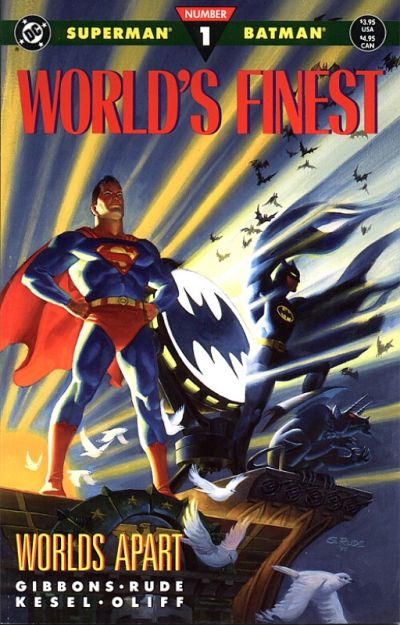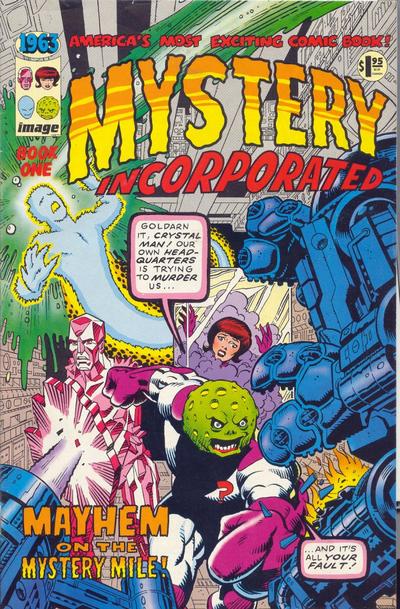Legendary artist Dave Gibbons enters the 13th Dimension for a wide-ranging interview about his career, then and now.
It’s hard to encapsulate the career of an artist and writer whose work has been so profoundly influential since the 1980s (and before, really). Gibbons, of course, drew the Sacred Scroll of Comicdom, “Watchmen.” That work alone changed the course of the entire industry.
But Gibbons is so much more. He’s worked on wide array of projects and books, including Britain’s 2000 AD, and he’s got many irons in the fire now.
So when given the opportunity to interview him, I naturally leapt at the chance. The 64-year-old, gentlemanly Gibbons was amazingly generous with his time — so much so that we at 13th Dimenions have decided to break up the interview into multiple parts, by theme, which will run on four consecutive Mondays.
We covered a lot of ground, including his career, his current projects and, yes, his thoughts on “Watchmen.”
Besides his own illustrious work — or, really because of it — Gibbons is something of a comics Zelig: He’s pretty much worked with all the best writers of the modern age. So to kick things off, here’s what he had to say about his collaborators and their individual styles.
You’ve worked with some of the industry’s greatest artists and writers. Describe what it’s like working with them and how their styles differ from other creators.
Dave Gibbons: Yeah, I’ve been lucky that I’ve worked with Alan Moore, Frank Miller, Pat Mills, John Wagner, Geoff Johns, Len Wein, all sorts of people. I’ve learned a lot from those writers and also with stuff I’ve written, I’ve worked with Mike Mignola and Steve Rude and Garcia-Lopez and other people I’m bound to miss out … Lee Weeks. And other people I’m lucky enough to call friends. And also I got to work with Stan Lee! And I’ve learned a lot. Everybody’s style and way of working is different.
Alan Moore is evidently very detailed in his instructions. Did that make it easier or harder?
Alan writes exhaustive scripts. He works on the basis that he’ll tell you every possible thought that he’s got. Then it’s up to you to use his suggestions or not as the fancy takes you. I was never intimidated by his scripts. He just gave you plenty of choices. The real thing was to actually go through the choices, work out what you actually wanted to do and take charge as an artist.
And Frank Miller, yeah, his scripts are much more impressionistic and he would swap pages in and out, change the order of pages. The thing that I always say about them is that they’re both like wonderful musicians. Alan is like Mozart who’d hear the whole symphony in his head and be able to write it all down complete whereas Frank is much more like a jazz virtuoso like Miles Davis who would, you know, know where he was going but be quite happy to improvise or incorporate different things that only occurred as the playing went along.
Both wonderful talents and I mean the two, probably, outstanding talents in comics in my lifetime so it’s a great honor and I was very lucky to have worked with people like that.
Steve Rude.
Absolute virtuoso artist. There’s a lot of people who are wonderful artists and … I wouldn’t call Steve an idiot savant because he’s by no means an idiot but he has a particularly well-developed visual sense and possibly he might even well say this himself but some of his other areas are not quite so developed. Maybe Simon Bisley is like this as well. You just absolutely are in awe of their God-like art talents and that is really … that talent is what defines them. But Steve is a great guy, a wonderful, enthusiastic guy and the absolute best for the script that I wrote for him for World’s Finest. He lifted what I’d done immeasurably!
Rick Veitch and Steve Bissette
I worked over his pencils and I wrote a script for him for Greyshirt. He’s a great guy, a great innovator, a real visionary who’s always prepared to break the mold and, again, like a double whammy, he writes as well as he draws. Same for Steve Bissette who, again, I got to ink some stuff for on the 1963 comics. Again, a great, visionary, wonderful, impressionistic style of drawing.
Do you ever talk to Alan Moore these days? What do you make of his recent comments about adult fans essentially being emotionally stunted?
I haven’t actually talked to Alan for a long time and I don’t think I’ve read his recent comments about adult fans essentially being emotionally stunted. I’m really reluctant to comment on it because … I don’t know … I really don’t want to get involved in any kind of dispute or disagreement or anything at all. If those are Alan’s views … fine.
What’s your take? Leave a comment below!







January 6, 2014
Dave Gibbons is one of the best artists in comics, period–and he’s no slouch as a writer, either! My favorite work of his is when he did Green Lantern and Tales of the Green Lantern Corps in the 1980s.